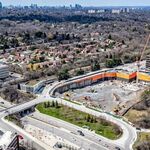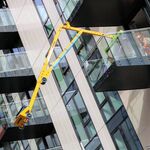MisterF
Senior Member
Great posts guys! I had no idea about the bike network in Minneapolis. Yet another example to disprove the "bike lanes are a waste because winter" argument.
Have they actually painted any of the permanent infrastructure yet on Richmond? When I was out that way on Friday, it was just lightly sketched, so one couldn't really blame the cars for ignoring it.This morning I was waiting for the light at Sherbourne and Richmond and watched at least 3 cars pull into the new bike lane to get out of the otherwise jammed traffic. So frustrating to watch.
Thanks for the compliment!Great posts guys! I had no idea about the bike network in Minneapolis. Yet another example to disprove the "bike lanes are a waste because winter" argument.
Have they actually painted any of the permanent infrastructure yet on Richmond? When I was out that way on Friday, it was just lightly sketched, so one couldn't really blame the cars for ignoring it.
They need excellent markings going all the way through the intersection like those used in other cities and other countries -- e.g. for left/right turning cars going through intersections. These HELP safety quite a LOT, as you can't install full protection inside the intersection. Whatever is done, the paint planning through an intersection now need to include bikes when connecting protected cycleways on both sides. Ideally, a full green-painted path painted all the way through the intersection, would be ideal.I rode the Richmond lane into work today. Bollards are not yet in place. Paint markings go from Parliament to Church at the moment (they are being extended a block or so every few days). It was nice, but there was only 1 other cyclist with me. I suspect that once they're fully built and publicized these will be well used. A welcome addition for Financial District cycle commuters like me.
Great posts guys! I had no idea about the bike network in Minneapolis. Yet another example to disprove the "bike lanes are a waste because winter" argument.
Some citations please? You just keep repeating the same thing over and over without any proof.College St also has one of the highest bike accident rates in the city. Riding a bike around streetcar tracks is dangerous. Also the number of people riding 506 streetcars vastly exceeds the number of people driving and riding bikes combined.
Outside of a handful of isolated areas around downtown, the number of people who ride bikes in the GTA is practically zero. Virtually no one rides bikes in Scarborough. It is extremely dangerous. People get killed while riding bikes regularly in the GTA even though very few people ride bikes. Riding a bike is the most dangerous method of transportation except motorcycling (which is even more dangerous).
I rode the Richmond lane into work today. Bollards are not yet in place. Paint markings go from Parliament to Church at the moment (they are being extended a block or so every few days). It was nice, but there was only 1 other cyclist with me. I suspect that once they're fully built and publicized these will be well used. A welcome addition for Financial District cycle commuters like me.
It seems like in fact, there's hardly much of a correlation between how good the typical climate and weather is and bike-friendliness, at least in North America.
Minneapolis and Chicago are snowy and bike-friendly, while places in Southern California or the Sunbelt more broadly that have more pleasing climates still favour automobile over cycling infrastructure.
http://usa.streetsblog.org/2014/04/...t-exert-much-influence-on-biking-and-walking/
If snow made a bigger difference as a deterrent, wouldn't you expect the less snow and the nicer the climate, the more people would bike and walk instead of driving?
College St also has one of the highest bike accident rates in the city. Riding a bike around streetcar tracks is dangerous. Also the number of people riding 506 streetcars vastly exceeds the number of people driving and riding bikes combined.
Outside of a handful of isolated areas around downtown, the number of people who ride bikes in the GTA is practically zero. Virtually no one rides bikes in Scarborough. It is extremely dangerous. People get killed while riding bikes regularly in the GTA even though very few people ride bikes. Riding a bike is the most dangerous method of transportation except motorcycling (which is even more dangerous).
Some citations please? You just keep repeating the same thing over and over without any proof.
per minute
There are multiple ways to measure death rates, but obviously, the question is how to improve these statistics. Protected cycle infrastructure is definitely one of them, and is very worthwhile in very condo-dense areas of Toronto, being an area of permanent new bike ridership.per person hour kilometer
College St also has one of the highest bike accident rates in the city. Riding a bike around streetcar tracks is dangerous. Also the number of people riding 506 streetcars vastly exceeds the number of people driving and riding bikes combined.
Outside of a handful of isolated areas around downtown, the number of people who ride bikes in the GTA is practically zero. Virtually no one rides bikes in Scarborough. It is extremely dangerous. People get killed while riding bikes regularly in the GTA even though very few people ride bikes. Riding a bike is the most dangerous method of transportation except motorcycling (which is even more dangerous).
They do plan to install bollards. We might get lucky and they might install some of the planters as well. I don't think green paint is planned at this time, and it should all be wrapped up by the end of the month.Update: markings are now painted on Richmond westbound from Parliament to Bay. For me this is great as my morning commute is now entirely in bike paths (Sherbourne & Richmond). Presumably they're going to install bollards too, and I would like it if the pavement was painted green (not sure if that's in the plan or not, since this is still a pilot project).
I would guess that the Richmond lane will keep being extended eastbound until it connects with the existing lane at Simcoe, then the Adelaide lane work would begin thereafter.
Thanks for attempting to bring a bit of data to this debate. The data in that link is from a survey that's over 15 years old…helmet usage and bike infrastructure have changed dramatically. It's also averaged over all ages and areas. Some more recent data from UBC can be found here:S
It is true. Different sources give different estimates but generally, per minute spent travelling by bike it's the second most dangerous after motorcycling.
The focus should be on how to get the rate down, in the same way that the aviation industry has steadily improved their safety record year over year.
Portland has managed to have a number of years with no cycling fatalities, despite a high rate of biking. Amsterdam and Copenhagen rarely have cycling fatalities despite (or because of) the dominant biking mode share.




